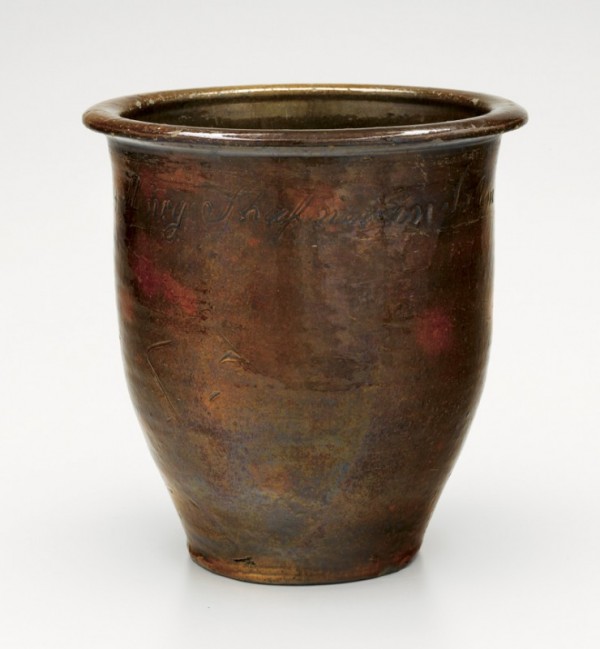
Creampot, Heinrich Schaffner, Salem, North Carolina, 1834. Lead-glazed earthenware. H. 9 1/8". Inscribed: “Henry Shafner in Salem NC Stokes County June 14 1834”. (Courtesy, Old Salem Museums & Gardens; unless otherwise noted, photos by Gavin Ashworth.) This creampot was thrown by Heinrich Schaffner after digging his first clay in Salem. It is signed with his anglicized name.

Albumen print of Heinrich Schaffner by Alanson E. Welfare, Salem, North Carolina, ca. 1865. (Courtesy, Moravian Archives.)
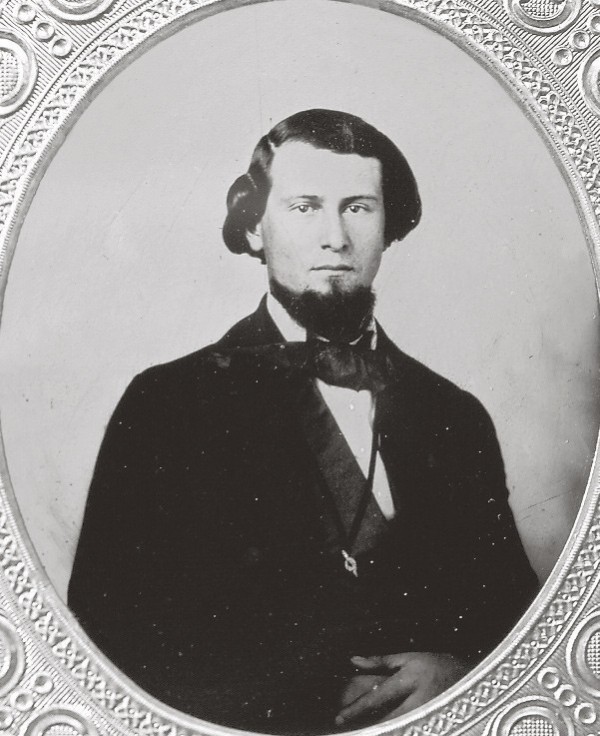
Tintype of Daniel Krause by unknown photographer, ca. 1865. (Courtesy, Old Salem Museums & Gardens.)
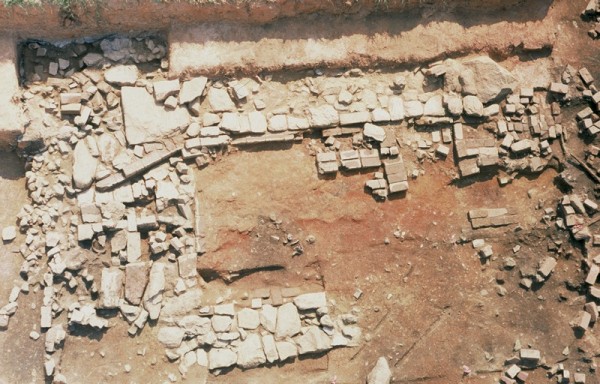
Kiln ruin, Schaffner-Krause pottery site, Winston-Salem, North Carolina, 2003. (Courtesy, Old Salem Museums & Gardens; photo, Michael O. Hartley.) Shown is a plan view of kiln remains at site, excavated by Old Salem Archaeology in the 2000–2003 field seasons. The firebox, which extended into the dryhouse, is in the choked-down area at the left, and the rectangular body of the kiln extends to the right. The lower arm of the kiln body is partially missing.
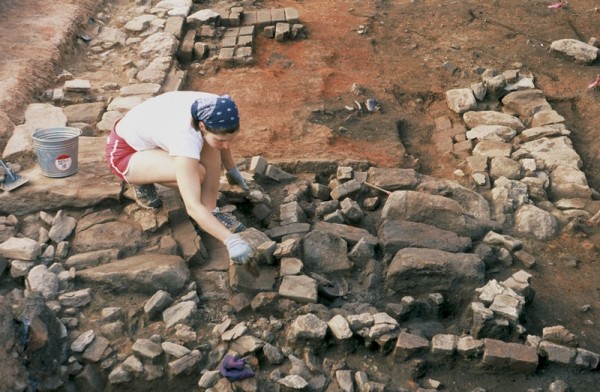
Excavation of kiln ruin, Schaffner-Krause pottery site, Winston-Salem, North Carolina, 2003. (Courtesy, Old Salem Museums & Gardens; photo, Michael O. Hartley.) An archaeology student cleans the firebox of the Schaffner-Krause pottery kiln.
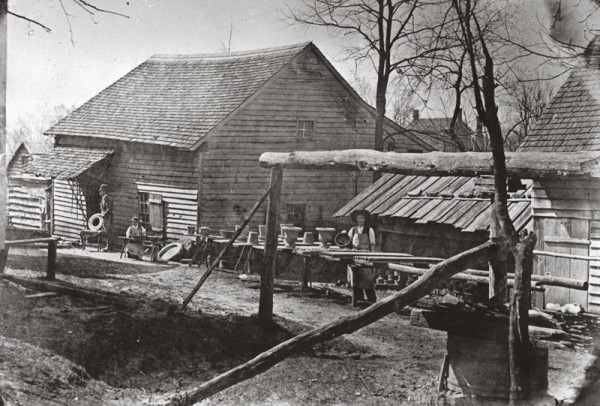
Photograph by E. F. Small of the Schaffner-Krause pottery, Winston, North Carolina, 1882. (Courtesy, Old Salem Museums & Gardens.) The pottery shop, which is at the left, was the first constructed building in Salem. Known as the “Builders’ House,” it was built in 1766 for the men from the nearby Moravian towns of Bethabara and Bethania who came to build the new town of Salem. Schaffner obtained permission to use this building in 1834 and constructed his pottery operation. The kiln is in the center of the photograph, and at the far right it attaches to the end of the dry house; note doorway into the dry house. A pug mill is in the foreground.
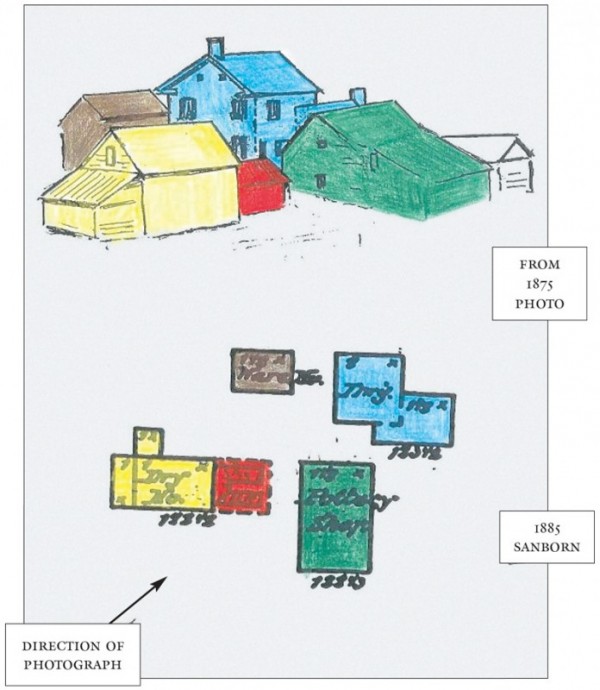
Schaffner-Krause pottery complex, as recorded on the Sanborn Insurance Map for 1885 and in a sketch made from a pre-1873 photograph. (Courtesy, Old Salem Museums & Gardens; photo and artwork, Michael O. Hartley.) The pottery shop is shown in green, the kiln in red, the dry house in yellow, and the warehouse in brown. The dwelling, indicated in blue, was constructed in the 1860s to replace Schaffner’s original house, which burned in 1863.
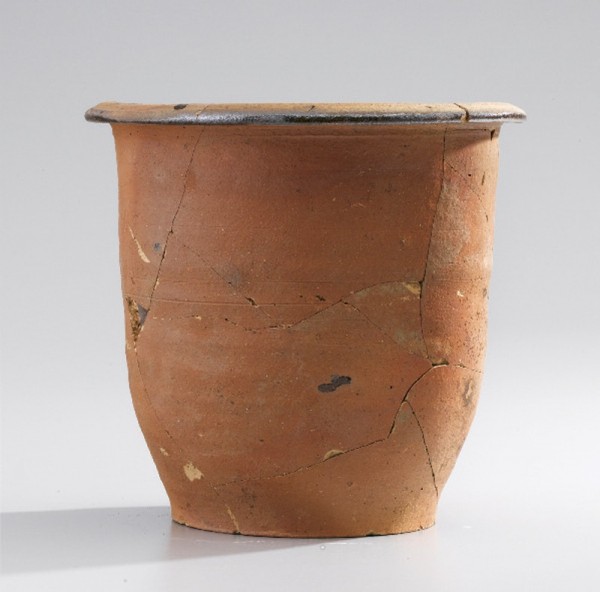
Creampot, Schaffner-Krause pottery, Salem, North Carolina, post-1834. Lead-glazed earthenware. H. 8 1/4". (Courtesy, Old Salem Museums & Gardens.) This nineteenth-century creampot follows the same basic form as eighteenth-century creampots manufactured in Salem and Wachovia. Unlike Schaffner’s creampot of June 14, 1834, illustrated in fig. 1, this example is glazed only on the interior, as was typical.
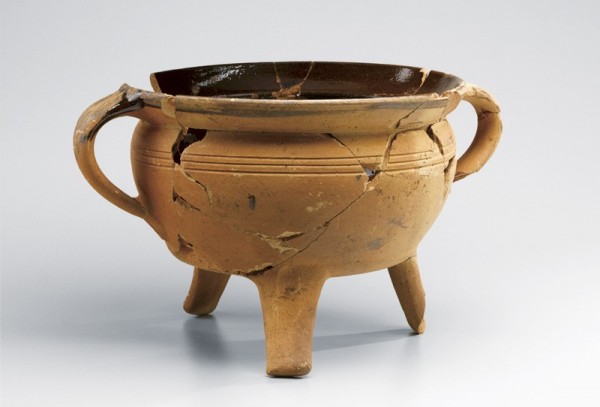
Flat-bottom cookpot with three legs, Schaffner-Krause pottery, Salem, North Carolina, post-1834. Lead-glazed earthenware. H. 8 3/8". (Courtesy, Old Salem Museums & Gardens.) The three legs on this basic flat-bottom form allowed this version to be used for hearth cooking over a bed of coals.

Flat-bottom cookpot with double handles, Schaffner-Krause pottery, Salem, North Carolina, post-1834. Lead-glazed earthenware. H. 5 3/8". (Courtesy, Old Salem Museums & Gardens.) This Schaffner-Krause cookpot utilizes the double-handle form seen on the three-legged cookpot illustrated in fig. 9, minus the legs.
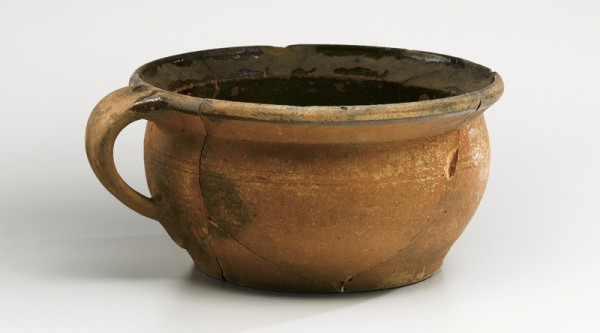
Flat-bottom cookpot with single handle, Salem, North Carolina, 1834–1860. Lead-glazed earthenware. H. 5". (Courtesy, Old Salem Museums & Gardens.) Contemporaneous with the cookpots illustrated in figs. 9 and 10, this third variation of the flat-bottom form was excavated at the Herbst House site in Salem and quite possibly was manufactured at the Schaffner-Krause pottery.
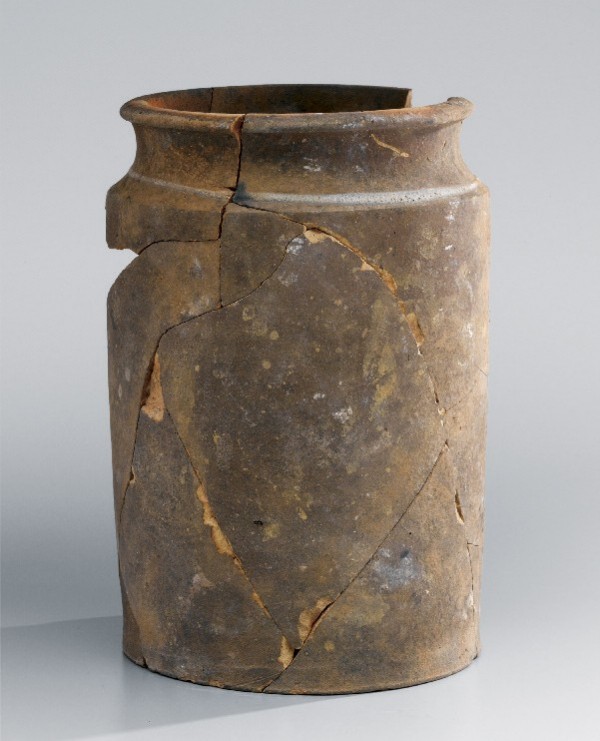
Apothecary jar, Schaffner-Krause pottery, Salem, North Carolina, post-1834. Earthenware. H. 8". (Courtesy, Old Salem Museums & Gardens.)
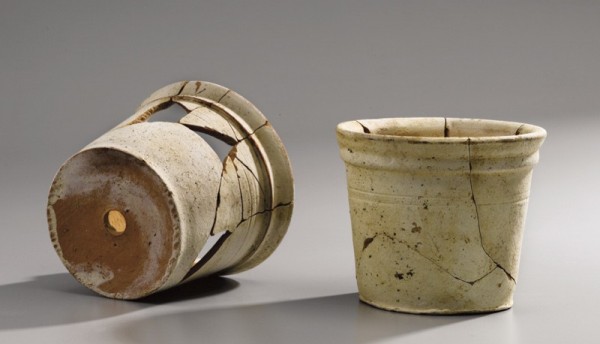
Flowerpots, Schaffner-Krause pottery, Salem, North Carolina, post-1834. Earthenware in bisque with slipped coating. H. 3 1/4". (Courtesy, Old Salem Museums & Gardens.) These two examples were among several flowerpots recovered at the Schaffner-Krause pottery site.
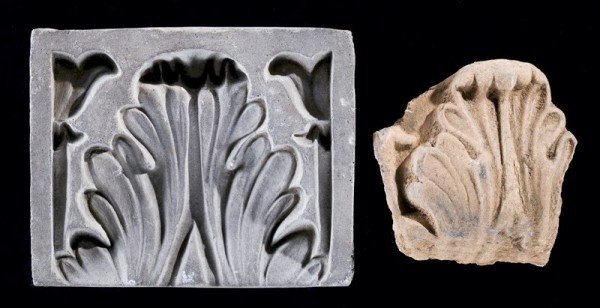
Acanthus-leaf mold and stove tile fragment, attributed to Heinrich Schaffner, Salem, North Carolina, post-1834. H. 31/2". (Courtesy, Wachovia Historical Society [mold] and Old Salem Museums & Gardens [fragment]; photo, Wesley Stewart.)
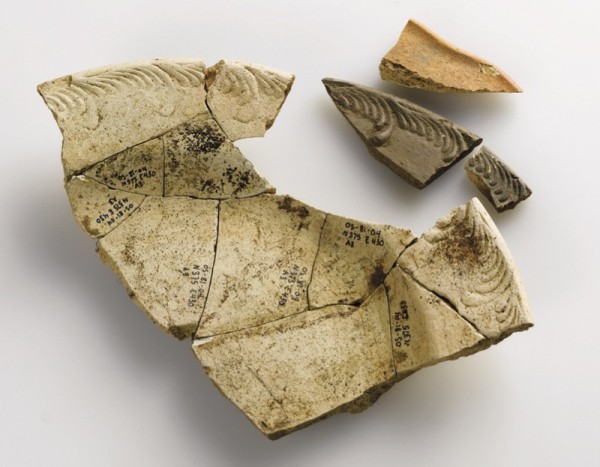
Reassembled portion of a feather-edged plate in buff bisque, two additional feather-edged fragments from a different mold in brown bisque, and a Royal-pattern sherd in orange bisque, Heinrich Schaffner, Salem, North Carolina, post-1834. Bisque-fired earthenware. Approximate projected D. of reassembled plate 8 1/2". Impressed on underside of reassembled plate: H.S. / SALEM / NC. (Courtesy, Old Salem Museums & Gardens.) All of these fragments were recovered from the Schaffner-Krause pottery site.
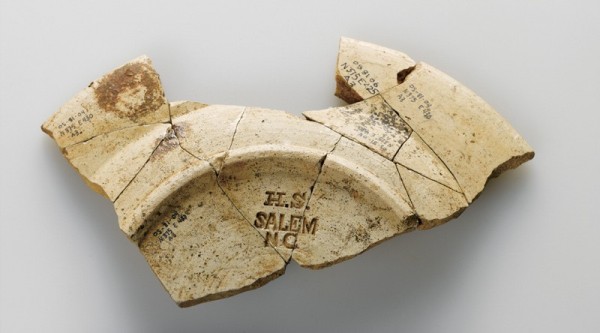
Bottom of the reassembled portion of the feather-edged plate illustrated in fig. 15. Schaffner’s stamp clearly demonstrates his production of creamware forms.

Hollow ware lid fragment decorated with sprig molding, Schaffner-Krause pottery, Salem, North Carolina, post-1834. Bisque-fired earthenware. Approximate projected D. 4". (Courtesy, Old Salem Museums & Gardens.) This fragment provides further evidence that Schaffner’s pottery produced English-style ceramics.

Salem about the year 1840, by unknown mapmaker. (Courtesy, Old Salem Museums & Gardens.) In 1834 Heinrich Schaffner established his pottery operation at the Builders’ House, constructed in 1766, which had been used as a residence. The large building shown west of the pottery is the 1836 Salem Manufacturing Company, an early cotton mill.
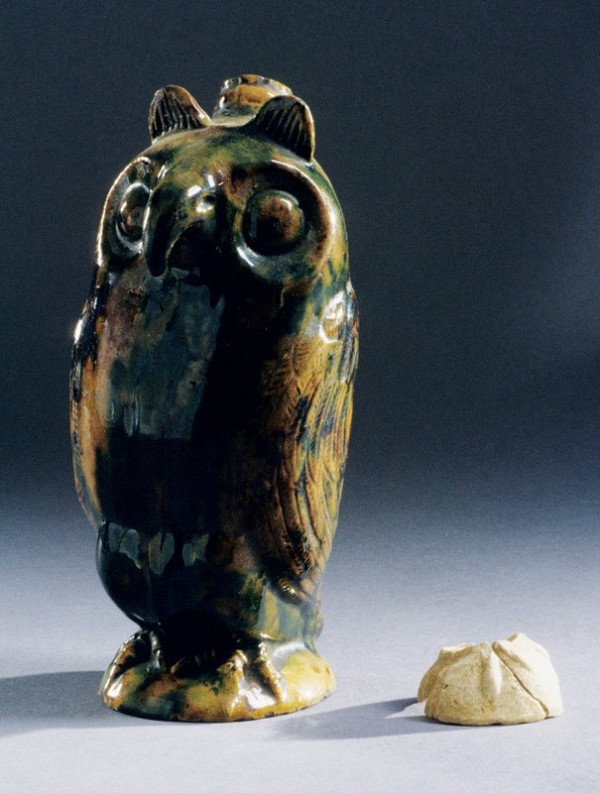
Left: Owl bottle, Salem, North Carolina, 1804–1840. Lead-glazed earthenware. H. 7 3/4". Right: Reconstructed fragment of the base of a bird bottle, Schaffner-Krause pottery, Salem, North Carolina, post-1834. Bisque-fired earthenware. (Courtesy, Old Salem Museums & Gardens; photo, Wesley Stewart.)

Left: Animal paw fragment, Schaffner-Krause pottery, Salem, North Carolina, post-1834. Bisque-fired earthenware. Right: Squirrel bottle, attributed to Rudolph Christ, Salem, North Carolina, 1804–1829. Lead-glazed earthenware. (Courtesy, Old Salem Museums & Gardens; photo, Wesley Stewart.) The paw fragment was recovered at the Schaffner-Krause pottery site.
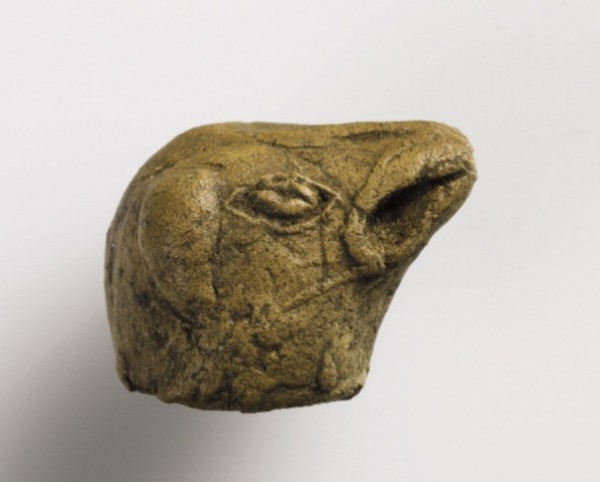
Molded animal head, Schaffner-Krause pottery, Salem, North Carolina, post-1834. Bisque-fired earthenware. L. 3/4". (Courtesy, Old Salem Museums & Gardens.)
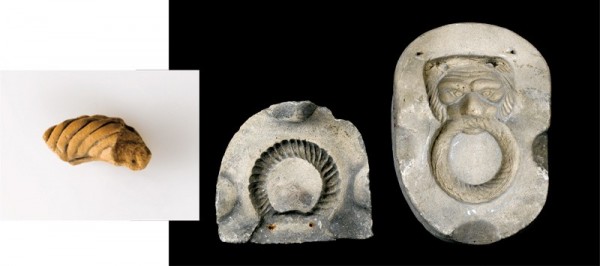
Left: Flowerpot handle fragment, Schaffner-Krause pottery, Salem, North Carolina, post-1834. Bisque-fired earthenware. (Courtesy, Old Salem Museums & Gardens.) Right: Lion’s-head mold, Salem, North Carolina, 1850–1870. Plaster. H. 5". (Courtesy, Wachovia Historical Society.) The provenance of the lion’s-head mold is unknown; however, the handle fragment was cast in it or in a similar mold.
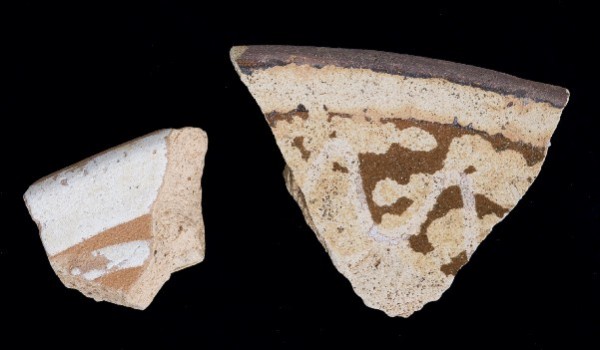
Slip-trailed decorated sherds, Schaffner-Krause pottery, Salem, North Carolina, post-1834. Bisque-fired earthenware with slip decoration. (Courtesy, Old Salem Museums & Gardens; photo, Wesley Stewart.) These sherds have been decorated with slip trailing but have not gone through the glost firing. Their discovery at the pottery site confirms the manufacture of these wares at the Schaffner-Krause pottery.
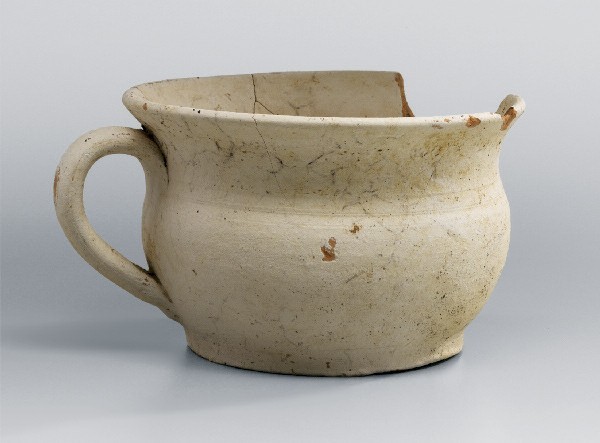
Pint cup, Schaffner-Krause pottery, Salem, North Carolina, post-1834. Bisque-fired earthenware with a slip coating. H. 3 1/8". (Courtesy, Old Salem Museums & Gardens.) This cup, which has been bisque fired and coated in a white slip, is an unfinished example from the Schaffner-Krause pottery; it is very similar to products made by eighteenth-century Moravian potters.
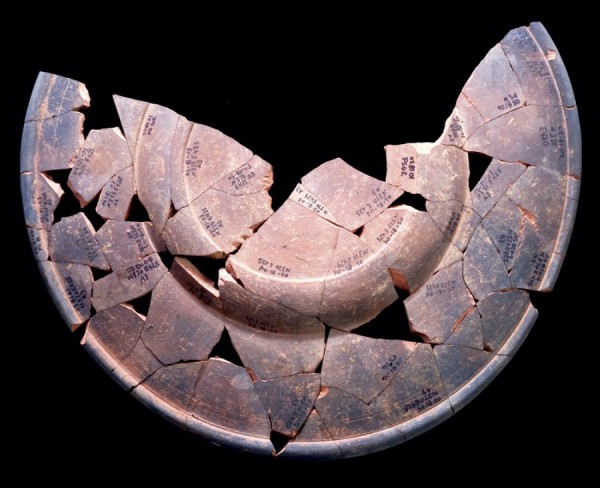
Plate, bottom view, Schaffner-Krause pottery, Salem, North Carolina, post-1834. Bisque-fired earthenware. D. across top 9 5/8". (Courtesy, Old Salem Museums & Gardens; photo, Wesley Stewart.) Warped through overfiring, this plate is an example of tableware produced at the Schaffner-Krause pottery.
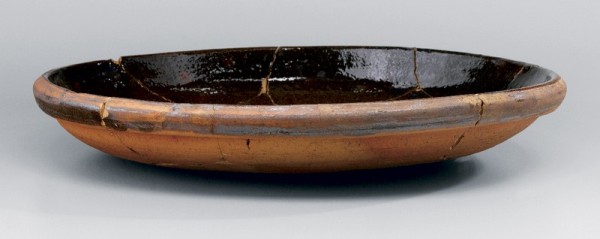
Pie dish, Schaffner-Krause pottery, Salem, North Carolina, post-1834. Lead-glazed earthenware. D. 10 1/4". (Courtesy, Old Salem Museums & Gardens.)
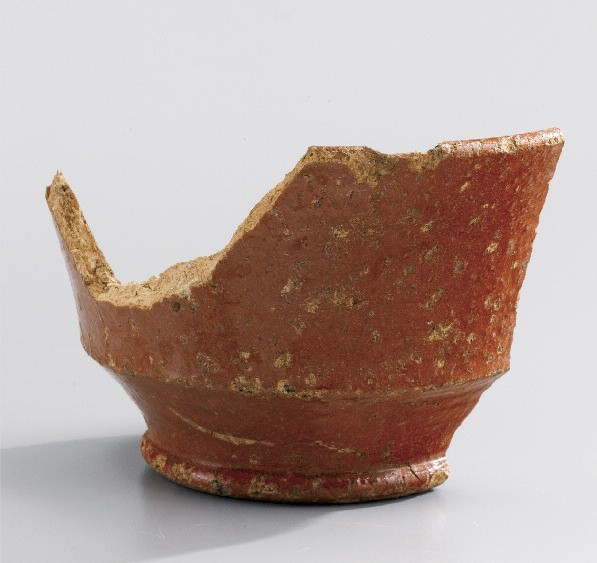
Cup, Heinrich Schaffner, Salem, North Carolina, post-1834. Lead-glazed earthenware. H. 3". Embossed on underside: H.S. / SALEM / NC. (Courtesy, Old Salem Museums & Gardens.) This cup is an archaeological surface find at Lot 51 in Salem, site of the 1767 Third House.
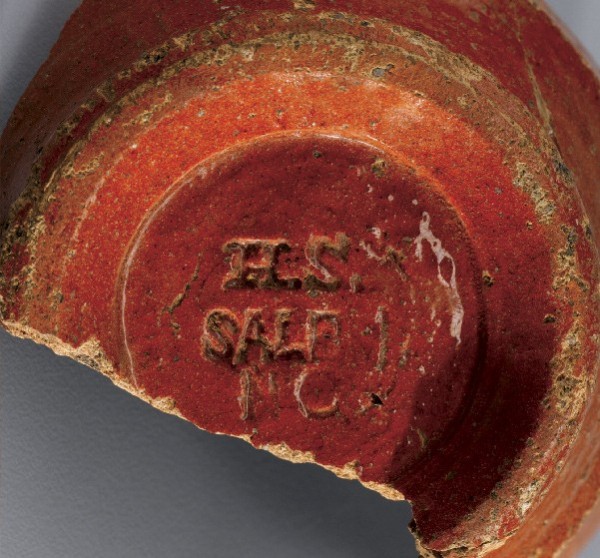
Detail of the base of the cup illustrated in fig. 27.
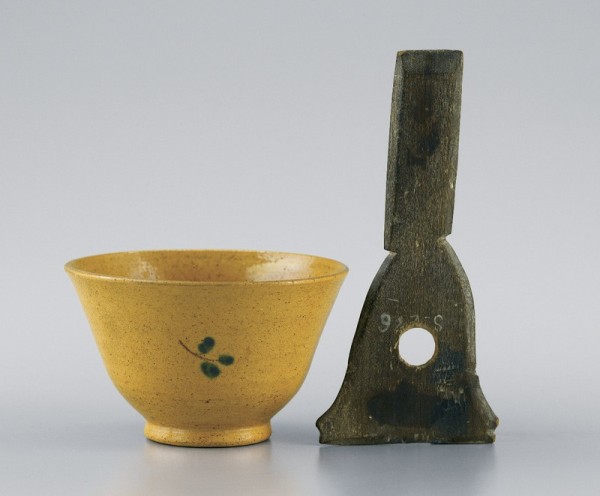
Left: Teacup, Heinrich Schaffner, Salem, North Carolina, post-1834. Lead-glazed earthenware. H. 2 5/8". (Courtesy, Old Salem Museums & Gardens.) Right: Potter’s rib, Heinrich Schaffner pottery shop, Salem, North Carolina. Wood. H. 5 7/8". (Courtesy, Wachovia Historical Society.)

Trivets, Schaffner-Krause pottery, Salem, North Carolina, post-1834. High-fired clay. (Courtesy, Old Salem Museums & Gardens.)
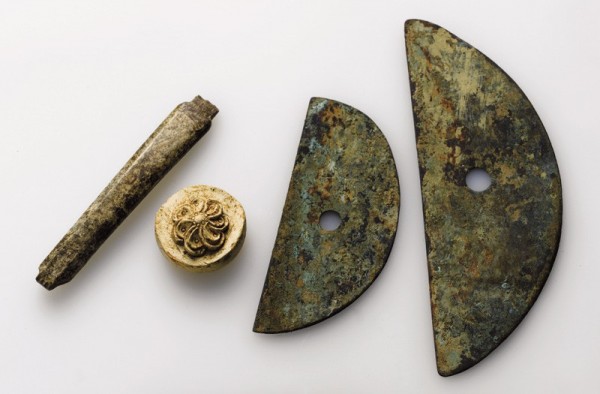
Bone tool, stamp mold, and brass ribs, Schaffner-Krause pottery, Salem, North Carolina, post-1834. L. of largest rib 5 5/8". (Courtesy, Old Salem Museums & Gardens.) The bone tool on the left was used to scribe bands and grooves into wheel-thrown vessels. The circular stamp produced floret impressions in wet vessels. The two brass potter’s ribs on the right were used to shape wheel-thrown pottery. All of these potter’s tools were found in direct relationship with the north foundation wall of the pottery shop during excavations.
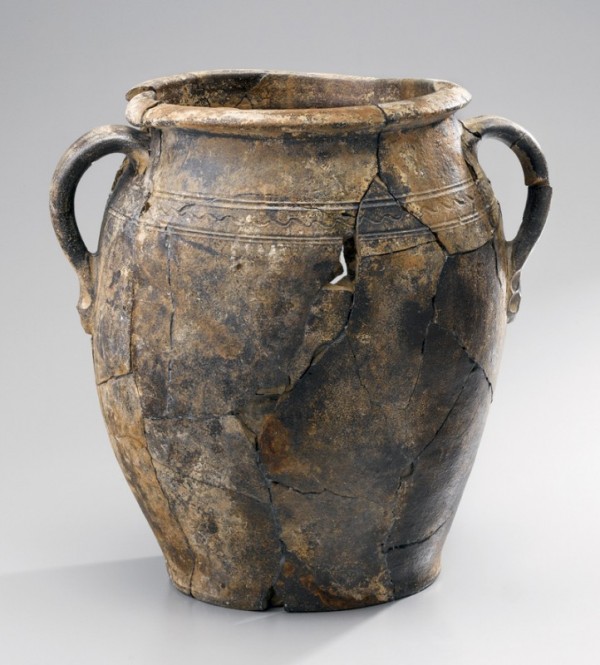
Crock, maker unknown, 1790–1820. Salt-glazed stoneware. H. 13 3/4". (Courtesy, Old Salem Museums & Gardens.) Though archaeologically excavated at the Schaffner-Krause pottery site, this crock was manufactured elsewhere; there is no evidence of the production or firing of salt-glazed stoneware at the Schaffner-Krause site. Recovered outside the doorway of the dry house, this crock probably was used for storing supplies.

Pipes and sagger pins, Schaffner-Krause pottery, Salem, North Carolina, post-1834. (Courtesy, Old Salem Museums & Gardens.) Pipe mold, unknown maker, post-1834. Metal. H. 2". (Courtesy, Wachovia Historical Society.) Moravian stub-stem pipes and pipe sagger pins were found archaeologically at the Schaffner-Krause pottery site. They are shown with a pipe mold from the Wachovia Historical Society that came from a Salem pottery shop. This mold perfectly fits a “Philosopher” pipe found at the pottery site.
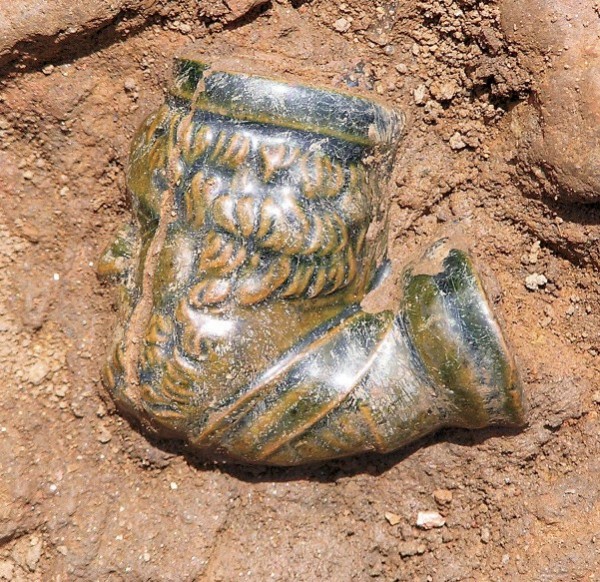
Tobacco pipe, Schaffner-Krause pottery, Salem, North Carolina, post-1834. Lead-glazed earthenware. (Courtesy, Old Salem Museums & Gardens; photo, Michael O. Hartley.) Green glazed “Philosopher” pipe found during excavations at the pottery site in 2004. This is another example of the pipe shown in the mold illustrated in fig. 33.
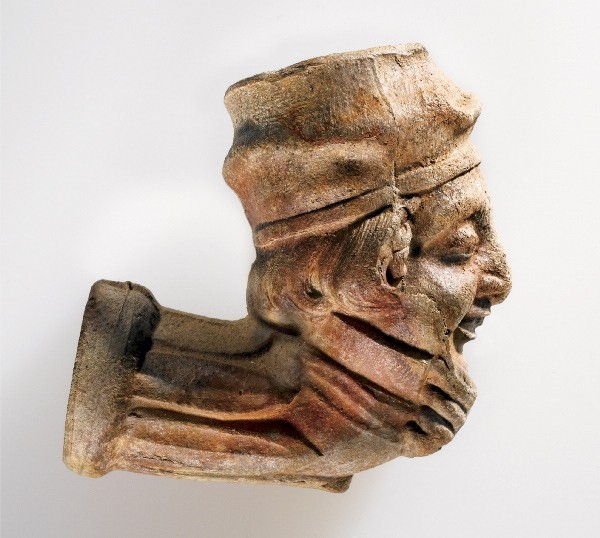
Tobacco pipe, Schaffner-Krause pottery, Salem, North Carolina, post-1834. Earthenware. (Courtesy, Old Salem Museums & Gardens.)
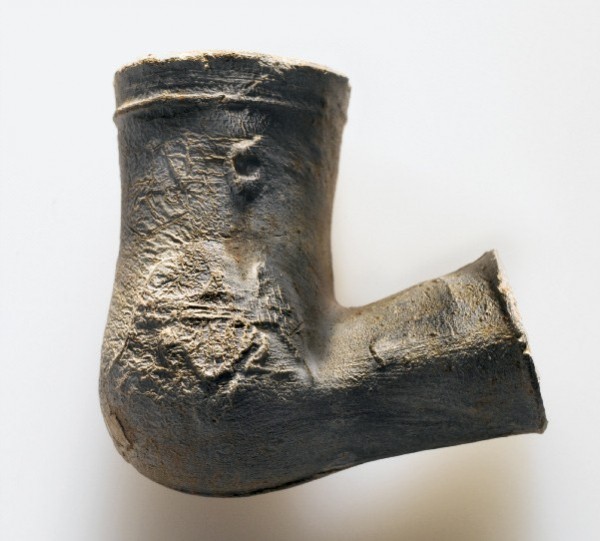
Tobacco pipe, Heinrich Schaffner, Salem, North Carolina, post-1834. Earthenware. (Courtesy, Old Salem Museums & Gardens.) Above the eagle is a “C”—a portion of the “NC” used in Schaffner’s mark.
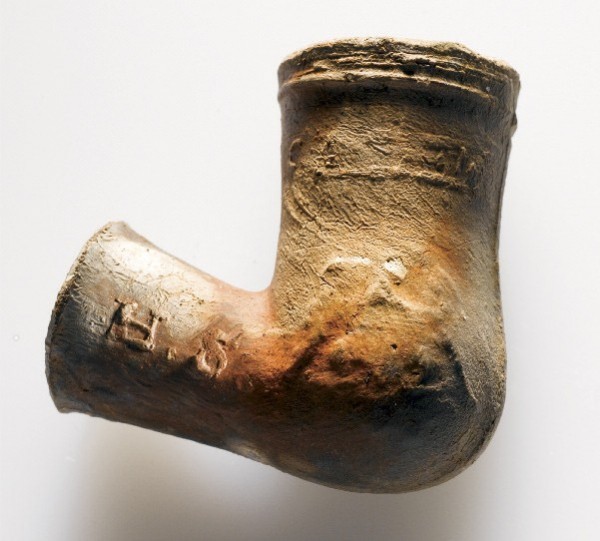
The reverse of the eagle pipe illustrated in fig. 36, showing Schaffner’s “H.S.” stamp on the stem. The smeared lettering directly under the crown reads “SALEM.”
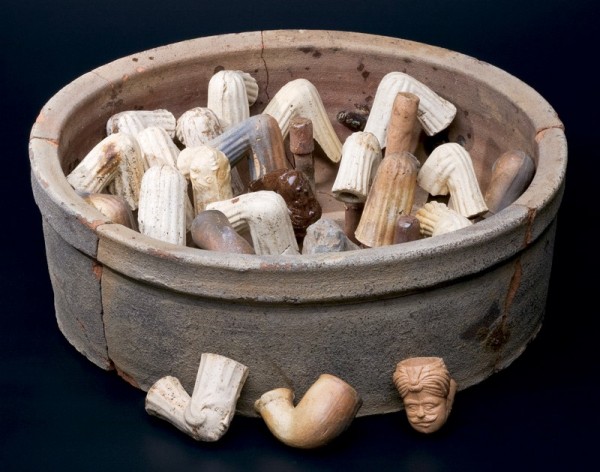
Loaded pipe sagger, Schaffner-Krause pottery, Salem, North Carolina, post-1834. D. 11 1/4". (Courtesy, Old Salem Museums & Gardens.) Pipes were fired in pipe saggers such as this one, loaded with 27 stub-stem pipes set on sagger pins. In the 1882 photograph of the pottery operation illustrated in fig. 6, the workman at center right is loading one of these saggers, taken from the racks of pipes on the trestle in front of him. Stacks of them are behind him against the kiln wall.

Augusta Crouse Masten, 1963; photograph by Jim Keith, Winston-Salem, North Carolina. (Forsyth County Public Library Photograph Collection.) Mrs. Masten, daughter of Daniel Crouse, the last master potter in Salem, was featured in a 1963 Winston-Salem Journal article entitled “She Made Salem Pipes.” Pictured here in her eighties, she is seated with pottery wares and is holding a Moravian stub-stem pipe, a product that from childhood she helped her father manufacture. Her father died in 1903; she operated the pottery for a year, but closed it when she could not find skilled help.
